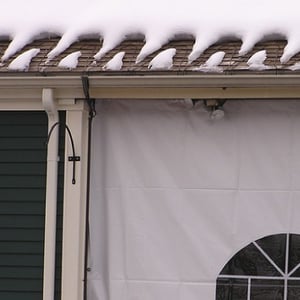
As our summer season fades into fall, we are fortunate to see the changing colors of the leaves and cooling temperatures. During this time, we begin to prepare our homes for the coming winter. This means blowing out sprinkler lines, raking up leaves, and making sure our heating systems are running up to par.
We also begin to think about where all the snow from our driveways and roofs will go. To help with snow accumulation before it is damaging to roofs and homes, some homeowners and property managers turn to heat tape and de-icing cables to do some of the work for us. Is this the right way to go?
To answer this question, we need to look at the root of the problem. Ice dams are caused by heat loss from a conditioned space into an unconditioned attic space, or directly through the building materials to the roof (if no attic space in between). This is due to inadequate air sealing and insulation between the conditioned living space and unconditioned attic space or roof. Heat then can escape melting snow on the roof which runs to the eave and then refreezes when it comes in contact with the freezing air. Hence, roof eaves and edges accumulate heavy ice formations —ice dams. We should be keeping the warm air inside our conditioned living space, and not heating the roof (this will also help the heating system work more efficiently!). If a cool roof is maintained, there is less chance of major and constant ice damming.
Without mitigation, ice dams can cause serious damage. First of all, the weight of these ice dams can weaken the integrity of the structure along the edges of your roof. More importantly, melting snow from escaping heat can seep directly through the roof. This then can cause water damage within the home—promoting biological growth and degrading insulation, paint, and wood. Aside from the damage you can initially see, it is important to recognize the damage caused to insulation, and other materials or spaces which may not be instantly visible.
It is a vicious cycle! Moisture leakage compromises the underlying insulation allowing for more heat loss through the roof causing snow to melt even more allowing more leakage and on and on. In other words, heat tape and de-icing cables only mitigate the symptoms of the problem and do not fix it. Plainly, proper air sealing and roof insulation will curb excessive snow melt from occurring, helping to prevent ice dams.
Now, let’s consider the costs of heat tape and de-icing cables. Not only will you need to purchase the product, which can cost upwards of $200 at Home Depot for 100 feet, you most likely with have to have a contractor install it to be sure it is correctly positioned with proper materials. On average, labor-only installation can cost $300-$400 to install 100 feet of tape.
Aside from installation costs, you need to consider operational costs. De-icing cables use about 6 watts of electricity per foot at 32°F, and even more at lower temperatures. If 100 linear feet of cable is utilized for 6 months of the year, it will consume more than 2600 kWh (kilowatt hours) of electricity at a cost of $300. You are now looking at total bill for the first year of almost $1,000—this amount includes materials, installation, and operation for the first year—with a continual operational cost of around $300 per year of operation.
On a side note, if you are using heat tape and/or de-icing cables be sure to operate it appropriately. It is only necessary to have it turned on during cold/snowy months, typically for our area, this would be November to March/April. Additionally. You should only run it from 6AM to 6PM daily. This is an optimal time since natural sunlight will help melt snow and ice. Putting it on a hard-wired timer installed by an electrician is also recommended.
This brings us back to the original question: Are heat tape and de-icing cables the right way to go? It is generally a better return on investment to mitigate the problem, not the symptoms. How do you do this?
- Request a home energy assessment from Walking Mountains Science Center.
- Review your report and speak with an Energy Coach.
- Request bids from contractors to have your home comprehensively air sealed and insulated.
- Reap the rewards. You will see lower energy bills and will be eligible for rebates from Walking Mountains and possibly your utility provider(s).
For more information, please contact an Energy Coach at Walking Mountains Science Center at 970-328-8777 or email energy@walkingmountains.org.
Sources:
https://www.roofcalc.org/roof-heat-cable-calculator/
https://home-partners.com/articles/ice-dams-quick-fixes-cure
https://bct.eco.umass.edu/publications/articles/preventing-ice-dams/







